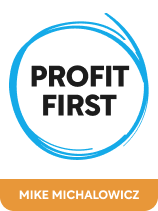

This article is an excerpt from the Shortform book guide to "Profit First" by Mike Michalowicz. Shortform has the world's best summaries and analyses of books you should be reading.
Like this article? Sign up for a free trial here .
How common is business debt? What are some things you can do to reduce your company’s debt burden?
Studies show that 79 percent of all U.S. small and medium companies are in debt, and that 58 percent of all U.S. small and medium companies are over $50,000 in debt. According to Mike Michalowicz, the author of Profit First, pulling out of debt begins with ruthlessly cutting your expenses.
Here’s how to get out of business debt in three steps, according to Michalowicz.
1. Be Ruthless in Cutting Expenses
In his book Profit First, Mike Michalowicz explains how to get out of business debt. The first step, he says, is to find a way to make your expenses less than your current adjusted revenue. You can’t compromise on this, because if you do you’ll just continue to increase your debt. Reduce expenses using the “keep, improve, remove” method we explored at the beginning of this chapter, and be particularly vigilant in checking and rechecking them for ways you can save money. Continue to cut expenses until your expense allocation percentage is 10 percent below the typical percentage for a company of your business’s size. This extra amount cut is a safety net, just in case you need to take back a few expenses to keep things running.
| Where to Cut Costs Quickly The extensive cuts recommended here might leave you overwhelmed, and wondering where you should look first for money to save. In a situation where you’re looking for expenses to cut, experts suggest that most businesses can start by cutting administrative costs. Specifically, they recommend you improve two different components of your business-wide organization, which will eliminate unnecessary costs. Improve communication: Improving communication throughout your business will allow you to save money, especially as you grow. This is because better communication makes it easier to spot redundancy in roles, tasks, or purchases—redundancies that are very common in larger companies. This could include something as small as making one company-wide purchase of paper instead of having different departments or employees making their own individual purchases. Or, it could include something as large as better circulating financial reports and analyses to prevent redundant research and make sure everyone knows the same information. Streamline management: By streamlining your management, you can ensure there’s no redundancy in the supervision of your employees. If you’re confident in the abilities of your employees and they don’t need to learn any new skills, then they probably don’t need close management. Experts recommend that each year the work of your employees stays the same, you should reduce time spent managing them by 10 percent. |
2. Spend Critically
While in debt, cancel any and all automatic payments. You need to know exactly how much you are spending when and to be critical of every single expense you make—every expense paid will be a conscious decision. Cancel all automatic credit card charges (you can do this by getting a new credit card with a new number from your bank), stop all automatic withdrawals from your accounts, and pay with checks instead.
(Shortform note: While Michalowicz advises you to think about each expense you make, you might be wondering how to do so effectively. Dan Ariely recommends in Predictably Irrational that you pause before buying something and ask yourself several questions. He advises you to ask yourself how your preference for this purchase started, if the purchase is worth the time and money you spend on it, and if there’s a better way you can spend your money. Answering these questions allows you to rationally think about your behavior and recognize if your purchase is due to a habit or due to what you genuinely need.)
3. Paying Down Your Debts
Once you’ve applied the first two methods to make sure you aren’t taking on any more debt, then you can start paying off your existing debts. Michalowicz outlines two guidelines you should follow while doing so.
Alter Profit Distribution
When you take out half of the money in your profit savings account each quarter for your personal use, 99 percent of that money should go towards paying your debts. Keep one percent for yourself so you can still feel rewarded for your success. Doing this keeps you from spending your tax money or salary on debts and further incentivizes you to keep your business stable and profitable.
Build Your Confidence
Pay your debts in order from smallest to largest, rather than by interest rate. Pay minimums for all other debts, and use what’s left to pay down the smallest one. This builds confidence in your ability to pay debts and makes paying them all off seem achievable.
Like much of the Profit First method, this emphasizes how the average person thinks over what’s the most logical. Paying your highest interest debts first makes more sense logically, but starting with your most daunting debts is far more likely to lead to you giving up. Instead, prove to yourself that paying back debt is possible and you’ll do so more consistently.
| Practical Guidelines for Paying off Debts While Michalowicz explains how to approach the process of paying off debts, you might still want practical advice on how to manage your finances while doing so. Dave Ramsey provides some practical tips in The Total Money Makeover—specifically, he explains how to prioritize debt payments in your finances, as well as how you can get started paying your debts. 1) If you have absolutely no cash on hand to start paying off even your smallest debt, then Ramsey emphasizes that you need to start selling your possessions. You’ll have to make sacrifices, but he says it’s all in service of having financial stability as well as the things you want in the future. 2) In contrast to what Michalowicz recommends, Ramsey advises that you use more than just your profits to pay off your debts. In addition, he suggests you stop contributing to any retirement funds (like a 401(k)) and use that money to pay off debt. This is because debt has to be your first priority—focusing completely on paying off debt over a few months means you’ll be better off financially than if you’d paid less debt off while still contributing to your retirement account. However, Ramsey does concede that if you’re likely to be in debt for over 18 months then you should keep making contributions, since you won’t be able to become debt-free in a short amount of time. 3) Finally, Ramsey suggests that maintaining an emergency fund should take priority over paying off debt. This means that if you have to use money from your emergency fund, you should fill it back up before you continue to pay off debt. |

———End of Preview———
Like what you just read? Read the rest of the world's best book summary and analysis of Mike Michalowicz's "Profit First" at Shortform .
Here's what you'll find in our full Profit First summary :
- Why traditional business accounting methods don't work
- How to use the Profit First method to increase your business’s profitability and stability
- How to assess your business's current financial health






